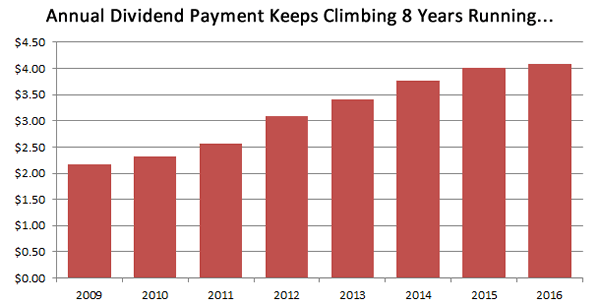My Top Dividend Stock for 2016

Income investors often use government bond yields as their benchmark. Securities issued by a stable government offer nearly guaranteed income since a government is unlikely to default on its debt.
The problem is that government bonds offer so little income right now. U.S. 10-year Treasury notes yield about 2.2%, while Canadian investors are earning just 1.5% on 10-year notes. In Europe, the situation is even worse. Swiss bonds are providing negative yields while bonds issued by Germany, France and the Netherlands are yielding less than 1%.
Rates this low will not protect income investors against inflation. The average rate of inflation over the past 100 years, according to InflationData.com, has been 3.22%. When inflation is greater than the interest rate, consumers lose buying power.
While the Federal Reserve is likely to raise interest rates next week, I don’t believe it will help income investors much. In the past, the Fed has raised rates slowly. It could take years for rates to return to levels that are comfortably above the rate of inflation.
In our current low-rate environment, income investors are looking beyond Treasuries. But high-quality corporate bonds aren’t much better. The iShares iBoxx $ Investment Grade Corporate Bond (NYSE: LQD) yields about 3.4%.
High-yield junk bonds offer more income but carry greater risk. For example, SPDR Barclays High Yield Bond ETF (NYSE: JNK) provides a yield of more than 6% but has a total return (including all those dividends) of just 1.3% over the past three years.
So if Treasuries, corporate bonds and junk bonds are all out, that leaves us with dividend stocks.
In looking at income stocks, it’s important to evaluate the safety of the dividend. Factors to consider include the amount of cash the business dedicates to its dividend, as well as how much cash the company needs to reinvest in operations to remain profitable.
My top dividend picks right now is Philip Morris International (NYSE: PM).
The company has paid a dividend as long as it’s been trading on the stock market, and it has an equally long history of raising its payment.

Most recently, the company raised its quarterly payment to $ 1.02 in October, giving the stock a forward annual dividend yield of 4.6%. And thanks to low reinvestment requirements, this high payout appears to be sustainable.
The financials confirm this. Philip Morris consistently reports operating income that’s 40% or more of gross revenue. And capital expenditures — money spent on expanding the business — account for just 4% of revenue, indicating the company’s reinvestment needs are relatively low.
In the past 12 months, dividends have accounted for about 23% of gross revenue, which means PM should be able to continue paying and even raising its dividend.
PM makes a great buy for any dividend investor, but I found a way to almost double its already impressive yield.
Double Your Income on High-Yielding PM
Last month, I advised readers of my Maximum Income service to use a covered call strategy on the stock. If you’re not familiar with it, don’t worry — covered calls are simple and profitable.
To illustrate, I’ll walk you through our trade.
On Nov. 16, PM was trading at $ 84.35. I recommended purchasing 100 shares of the stock, which cost traders $ 8,435. I also recommended selling one January $ 87.50 strike call option for around $ 0.70 ($ 70 per contract).
In doing so, we agreed to sell our 100 shares for $ 87.50 a piece if they are above that level when the option expires on Jan. 15. In return, the option buyer paid us $ 70 that is ours to keep no matter what, lowering our cost basis on the stock to $ 83.65.
Since we made this trade, PM has shot up to around $ 88. From here, one of two things can happen…
If PM is above $ 87.50 on Jan. 15, we’ll keep the $ 70 in income, but we’ll have to sell PM at $ 87.50. In this case, we’ll realize a profit of $ 3.85 per share ($ 87.50 – $ 83.65 cost basis), or $ 385 per 100 shares. This is a profit of 4.6% in 60 days. If we repeated a similar trade every 60 days, we’d earn a 28% return on our cost basis in 12 months. Compare that to the paltry yield of most income products!
Assuming PM trades for $ 87.50 or less on Jan. 15, we’ll keep the shares and the $ 70 premium on $ 8,435, earning 0.8% in 60 days. That may not seem like a lot, but consider this: We will have the opportunity to collect upcoming dividends and the chance to make more money selling covered calls.
Here’s what I told my Maximum Income readers about this scenario: “If we can repeat a similar trade on this position every few months, we’d collect about $ 4.25 per share — more than doubling the income we’d get from PM’s dividend. That’s enough to turn the stock’s already impressive 4.8% yield into a monster 9.9% income stream!”
Plus, this strategy can be used with more than just my recommendations. You can apply it to almost any stock currently sitting in your portfolio as long as you hold at least 100 shares.
I’ve put together a 90-second presentation that tells you ever

